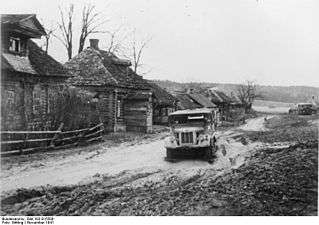Rasputitsa
Rasputitsa (Russian: распу́тица; IPA: [rɐsˈputʲɪtsə]) is the semiannual mud seasons when unpaved roads become difficult to cross in most of Eastern Europe.
Description
The term has been used historically to describe the condition in Belarus, Russia and Ukraine. The word has the same root as put (way). Literal translation of the term is thus closest to loss of ways; de-roading. The word may be explained as the "quagmire season," because during this period, the large flatlands become extremely muddy and marshy, as do most unpaved roads. The term applies to both the spring rasputitsa and autumn rasputitsa seasons, and to the condition of the roads during those seasons. The rasputitsa occurs more strongly in the spring due to the melting snow, but it usually recurs in the fall due to frequent heavy rains. Rasputitsa also means "lack of roads" as Pierre George explained in his book Géographie de l'URSS, «Que sais-je»?, 1963.
Wartime effects
Napoleon
Rasputitsa seasons of Russia are well known as a great defensive advantage in wartime.[1][2] Common nicknames in such context are General Mud or Marshal Mud. During the French invasion of Russia in 1812, Napoleon found the mud to be a great hindrance.[1][2]
World War II
During the Second World War, the month-long muddy period slowed down the German advance during the Battle of Moscow, and may have helped save the Soviet capital.[3] The Germans eventually developed the fully tracked Raupenschlepper Ost artillery tractor, which could cope with muddy conditions much better than wheeled vehicles, even their own extensive number of different half-tracked designs.
Gallery
-

Village street near Moscow, November 1941
-

Wehrmacht soldiers pulling car from the mud, November 1941
-

Wehrmacht horse carriage sunk in deep mud in Kursk Oblast, March–April 1942
Finland
The corresponding term in Finnish for the mud season is rospuutto, denoting "roadlessness". Most dirt roads in Finland turn into mud in this season. In olden days, when most roads were unpaved, this would make them virtually unusable; modern paved roads can be used now but are dangerously slippery. In the Archipelago, the period is known as kelirikko (literally "weather break"), implying the ice is too thin to bear the weight of people or vehicles. Seagoing vessels that are not equipped with icebreaker bows find it heavy going to get through ice. The only practicable vehicles during the kelirikko are hovercraft, hydrocopters or aircraft such as helicopters. Unlike in Russia, where heavy mud occurs in both the spring and fall seasons, the Finnish rospuutto and kelirikko occur mainly in the spring when the snow melts and the spring rains begin. Different climates (a little more humid in Finland, closer to the westerlies influx) and, especially, glacial topography and rocky soil, also in Finland, account for this difference.[4] In fact, extension of the Baltic Shield can be seen along the many lakes in Russia and Finland on the rocky and hummocky shield about 3.000 Million year old.
See also
| Wikimedia Commons has media related to Rasputiza. |
References
- 1 2 FAQ regarding what made Napoleon fail in invading Russia, Napoleon -series website
- 1 2 M. Adolphe Thiers (1864). History of the Consulate and the Empire of France under Napoleon. IV. Translated by D. Forbes Campbell; H. W. Herbert. Philadelphia: J. B. Lippincott & Co. p. 243.
whilst it was almost impossible to drag the gun-carriages through the half-frozen mud
(regarding November 20, 1812) - ↑ Overy, Richard (1997). Russia's War. London: Penguin. pp. 113–114. ISBN 1-57500-051-2.
Both sides now struggled in the autumn mud. On October 6 [1941] the first snow had fallen, unusually early. It soon melted, turning the whole landscape into its habitual trackless state – the rasputitsa, literally the ‘time without roads’. ... It is commonplace to attribute the German failure to take Moscow to the sudden change in the weather. While it is certainly true that German progress slowed, it had already been slowing because of the fanatical resistance of Soviet forces and the problem of moving supplies over the long distances through occupied territory. The mud slowed the Soviet build-up also, and hampered the rapid deployment of men and machines.
- ↑ Geology of Fennoscandia